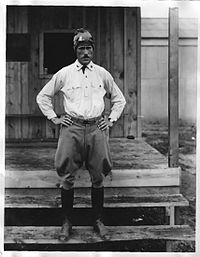- Clarence L. Tinker
-
Clarence L. Tinker 
Clarence L. Tinker circa 1920Born November 21, 1887
near Pawhuska, OklahomaDied June 7, 1942 (aged 54)
Midway IslandBuried at His body was never recovered. Allegiance  United States of America
United States of AmericaYears of service 1912–1942 Battles/wars World War II Awards Soldier's Medal
Distinguished Service MedalGeneral Clarence Leonard Tinker (1887–1942) was an airman of who lost his life during World War II while on a combat mission during the Japanese attack on Midway Island in the Pacific, June 7, 1942. Tinker Air Force Base in Oklahoma City, Oklahoma is named in his honor. Tinker was an enrolled member of the Osage Nation.
One-eighth Osage Indian, Clarence Tinker was born on November 21, 1887 near Pawhuska, Oklahoma in the Osage Nation. His maternal grandmother was half-Osage, with both her parents being children of the marriage of Osages with Aracadian Frenchmen from Louisiana. Tinker, the eldest son of George E. Tinker and Sarah A. Schwagerte, received his elementary education in Catholic institutions at Hominy and Pawhuska, Oklahoma, and the Elgin, Kansas public school. While growing up, he worked in the print shop of the Wah-Sha-She News, which his father founded and published. Beginning in 1900 Tinker attended the Haskell Institute, the famous Indian school in Lawrence, Kansas, but withdrew before graduating. In the fall of 1906, Tinker enrolled at Wentworth Military Academy in Lexington, Missouri. Upon graduating from Wentworth in 1908 Tinker was commissioned a third lieutenant in the Philippine Constabulary.
He received his commission as a Lieutenant in the U.S. Army infantry in March 1912. After infantry training, Tinker joined the Twenty-fifth Infantry Division at Fort George Wright in Spokane, Washington. During World War I, Tinker served in the Southwestern United States and California, and was promoted to Major. In 1919, Tinker began flying lessons. One of his assignments after the War was with the ROTC at Riverside High School. When his father came to visit him at the school they began a conversation in Osage in public. This use of the language was one of the ways that Tinker publicly demonstrated his Osageness. Shortly thereafter, he transferred to the Army Air Service, and on July 1, 1922, he was assigned to flight duty. For a time Tinker was the air attache to the US embassy in London. He also was at the Army Command and Staff College in the same class as Dwight D. Eisenhower. In 1927, he was named Commandant of the Air Service Advanced Flying School at Kelly Field, Texas. Tinker commanded various pursuit and bombardment units during the 1930s. He was steadily promoted, and on October 1, 1940, became a brigadier general.
After the Japanese attack on Pearl Harbor, Tinker was named Commander of the Air Forces in Hawaii to reorganize the air defenses of the islands. In January 1942, he was promoted to Major General, the First American Indian in U.S. Army history to attain that rank. In June 1942, the Japanese began their assault of Midway Island. In the midst of the Battle of Midway, on June 7, General Tinker decided personally to lead a force of early model B-24s against the retreating Japanese naval forces. Near Midway Island his plane was seen to go out of control and plunge into the sea. General Tinker and eight crewmen perished. His body was never recovered.
Clarence L. Tinker was the first American General killed in World War II. He received the Soldier's Medal in 1931 and was posthumously awarded the Distinguished Service Medal. On October 14, 1942, the Oklahoma City Air Depot was named Tinker Field in his honor. It is now known as Tinker Air Force Base.
References
- The Story of Wentworth, by Raymond W. Settle, 1950, Spencer Printing Co., Kansas City.
External links
Categories:- 1887 births
- 1942 deaths
- Native American United States military personnel
- Osage Nation
- People from Osage County, Oklahoma
- Recipients of the Soldier's Medal
- Air Corps Tactical School alumni
- United States Army Air Forces generals
Wikimedia Foundation. 2010.
